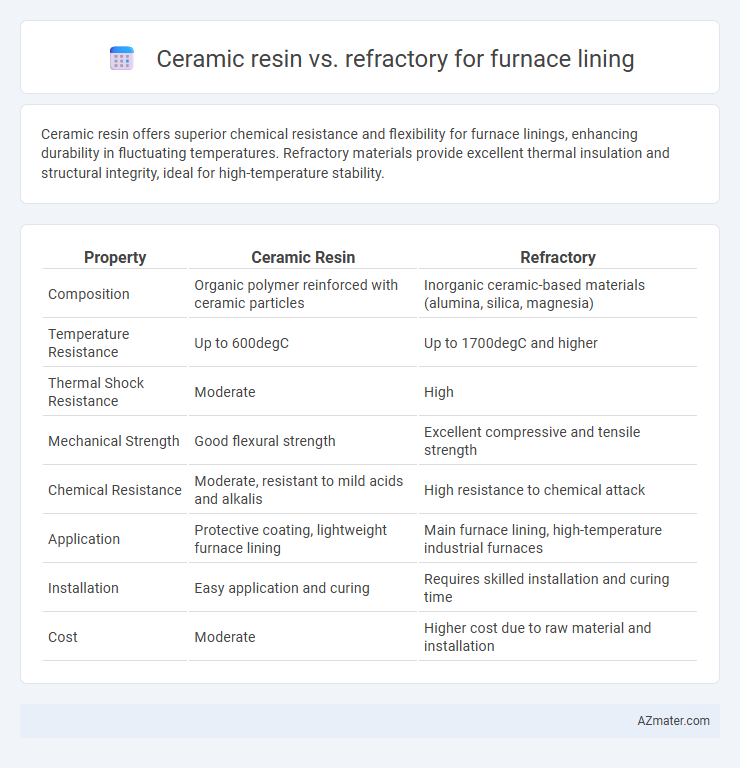Ceramic resin offers superior chemical resistance and flexibility for furnace linings, enhancing durability in fluctuating temperatures. Refractory materials provide excellent thermal insulation and structural integrity, ideal for high-temperature stability.
Table of Comparison
| Property | Ceramic Resin | Refractory |
|---|---|---|
| Composition | Organic polymer reinforced with ceramic particles | Inorganic ceramic-based materials (alumina, silica, magnesia) |
| Temperature Resistance | Up to 600degC | Up to 1700degC and higher |
| Thermal Shock Resistance | Moderate | High |
| Mechanical Strength | Good flexural strength | Excellent compressive and tensile strength |
| Chemical Resistance | Moderate, resistant to mild acids and alkalis | High resistance to chemical attack |
| Application | Protective coating, lightweight furnace lining | Main furnace lining, high-temperature industrial furnaces |
| Installation | Easy application and curing | Requires skilled installation and curing time |
| Cost | Moderate | Higher cost due to raw material and installation |
Introduction to Furnace Lining Materials
Furnace lining materials such as ceramic resin and refractory play crucial roles in maintaining high thermal efficiency and structural integrity under extreme temperatures. Ceramic resin offers advantages in chemical resistance and flexibility, making it suitable for specific high-temperature applications where rapid cooling or thermal shock resistance is needed. Refractory materials, characterized by their high melting points and durability, are traditionally preferred for heavy-duty industrial furnaces, providing long-lasting insulation and protection against thermal degradation.
What is Ceramic Resin?
Ceramic resin is a high-performance binding material used in furnace lining that combines ceramic particles with a resin matrix to provide enhanced thermal stability and mechanical strength. This composite material offers superior resistance to heat, corrosion, and thermal shock compared to traditional refractory bricks, making it ideal for harsh furnace environments. Its ability to form dense, crack-resistant linings improves furnace durability and energy efficiency in industrial high-temperature applications.
Understanding Refractory Materials
Refractory materials for furnace lining, such as ceramic resin and traditional refractory bricks, differ significantly in thermal stability and chemical resistance. Ceramic resin offers enhanced bond strength and quicker installation time due to its polymer matrix, making it ideal for high temperature applications up to 1200degC. In contrast, conventional refractory bricks provide superior durability and insulation at extreme temperatures above 1600degC, essential for metallurgical and industrial furnaces operating under prolonged thermal stress.
Key Properties: Ceramic Resin vs Refractory
Ceramic resin offers high thermal stability and excellent chemical resistance, making it ideal for furnace linings exposed to rapid temperature changes and corrosive environments. Refractory materials excel in withstanding extreme temperatures above 1500degC and provide superior mechanical strength and thermal insulation, essential for maintaining furnace efficiency. The choice between ceramic resin and refractory depends on operational temperature ranges and the chemical aggressiveness of the furnace atmosphere.
Thermal Performance Comparison
Ceramic resin linings offer superior thermal insulation with lower thermal conductivity values around 0.2-0.4 W/m*K, enhancing energy efficiency by reducing heat loss in furnace applications. Refractory linings exhibit higher thermal mass and can withstand extreme temperatures up to 1800degC, providing excellent durability and resistance to thermal shock, but typically have higher thermal conductivity in the range of 1.0-3.0 W/m*K. The choice between ceramic resin and refractory materials depends on the specific furnace operating temperature, thermal cycling conditions, and desired balance between insulation performance and structural robustness.
Durability and Lifespan Assessment
Ceramic resin furnace linings exhibit superior durability due to their enhanced thermal shock resistance and chemical inertness, often lasting 30-50% longer than traditional refractory materials. Refractory linings, while effective at high temperatures, tend to degrade faster under cyclic thermal stresses and chemical corrosion, leading to more frequent maintenance and replacement cycles. Evaluating lifespan, ceramic resin linings can maintain structural integrity beyond 10,000 heating cycles, whereas refractory linings typically require refurbishment after 6,000-8,000 cycles.
Installation Methods and Ease
Ceramic resin furnace linings offer a straightforward installation process due to their lightweight composition and ability to cure at ambient temperatures, reducing downtime and labor costs. Refractory linings, in contrast, require more complex installation techniques, including high-temperature curing and precise layering to ensure durability and thermal resistance. The ease of handling ceramic resin materials translates to faster application and maintenance compared to the labor-intensive and time-consuming refractory lining methods.
Cost Analysis: Ceramic Resin vs Refractory
Ceramic resin furnace linings typically offer lower initial installation costs due to easier application methods and reduced labor requirements compared to traditional refractory materials, which demand longer curing times and specialized handling. However, refractory linings often provide superior durability and higher temperature resistance, potentially lowering long-term maintenance and replacement expenses. Cost analysis should weigh immediate installation savings of ceramic resin against the lifecycle benefits and resilience of refractory linings in high-temperature industrial applications.
Typical Applications and Industries
Ceramic resin linings are primarily used in industries requiring chemical resistance and thermal insulation, such as chemical processing and high-temperature furnaces in metallurgy. Refractory materials dominate applications demanding extreme heat resistance and mechanical strength, including steel production, glass manufacturing, and cement kilns. Both materials optimize furnace efficiency, with ceramic resins favored for moderate heat and corrosive environments, while refractories excel in intense thermal and abrasive conditions.
Choosing the Best Lining for Your Furnace
Ceramic resin linings offer superior thermal shock resistance and faster curing times, making them ideal for furnaces that require quick turnaround and frequent temperature changes. Refractory linings provide exceptional durability and high-temperature stability, suitable for furnaces operating at extreme temperatures over prolonged periods. Selecting the best lining depends on your furnace's operational temperature, thermal cycling frequency, and maintenance schedule to optimize performance and longevity.

Infographic: Ceramic resin vs Refractory for Furnace lining
 azmater.com
azmater.com